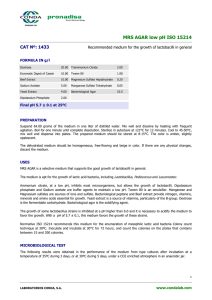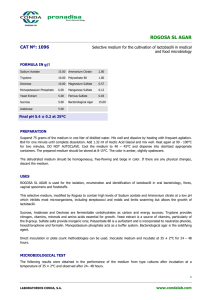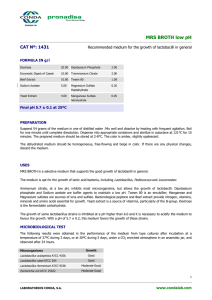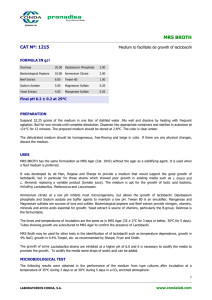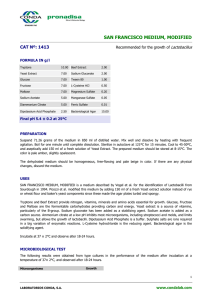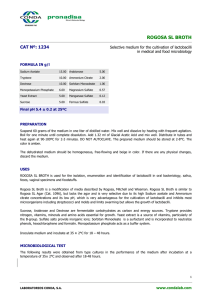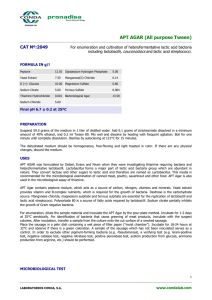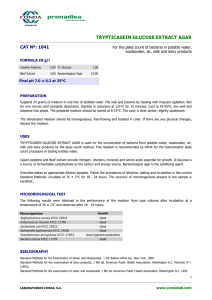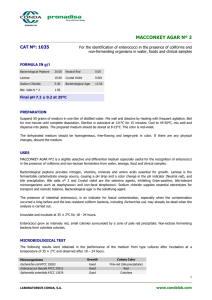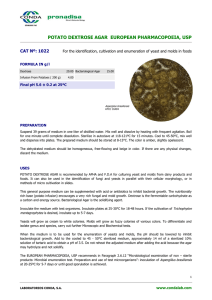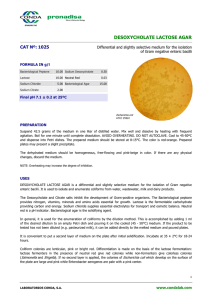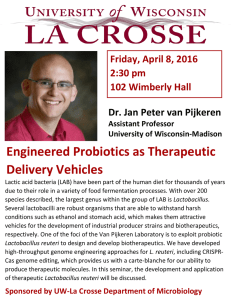MRS AGAR CAT Nº: 1043 l
advertisement
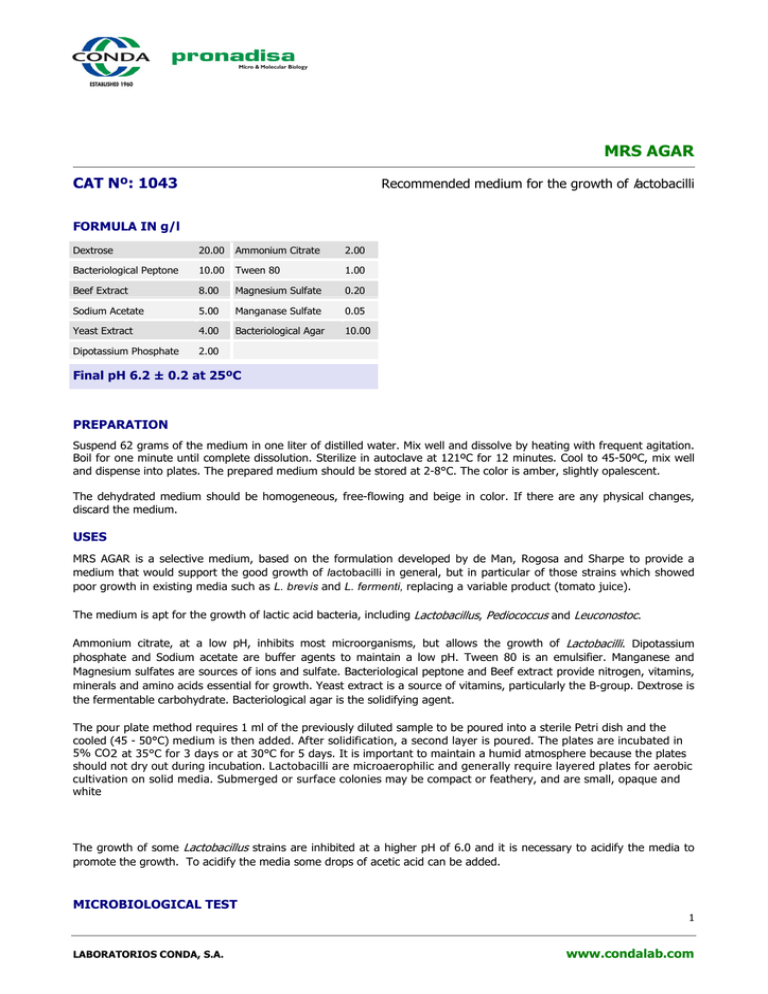
MRS AGAR CAT Nº: 1043 Recommended medium for the growth of lactobacilli FORMULA IN g/l Dextrose 20.00 Ammonium Citrate 2.00 Bacteriological Peptone 10.00 Tween 80 1.00 Beef Extract 8.00 Magnesium Sulfate 0.20 Sodium Acetate 5.00 Manganase Sulfate 0.05 Yeast Extract 4.00 Bacteriological Agar 10.00 Dipotassium Phosphate 2.00 Final pH 6.2 ± 0.2 at 25ºC PREPARATION Suspend 62 grams of the medium in one liter of distilled water. Mix well and dissolve by heating with frequent agitation. Boil for one minute until complete dissolution. Sterilize in autoclave at 121ºC for 12 minutes. Cool to 45-50ºC, mix well and dispense into plates. The prepared medium should be stored at 2-8°C. The color is amber, slightly opalescent. The dehydrated medium should be homogeneous, free-flowing and beige in color. If there are any physical changes, discard the medium. USES MRS AGAR is a selective medium, based on the formulation developed by de Man, Rogosa and Sharpe to provide a medium that would support the good growth of lactobacilli in general, but in particular of those strains which showed poor growth in existing media such as L. brevis and L. fermenti, replacing a variable product (tomato juice). The medium is apt for the growth of lactic acid bacteria, including Lactobacillus, Pediococcus and Leuconostoc. Ammonium citrate, at a low pH, inhibits most microorganisms, but allows the growth of Lactobacilli. Dipotassium phosphate and Sodium acetate are buffer agents to maintain a low pH. Tween 80 is an emulsifier. Manganese and Magnesium sulfates are sources of ions and sulfate. Bacteriological peptone and Beef extract provide nitrogen, vitamins, minerals and amino acids essential for growth. Yeast extract is a source of vitamins, particularly the B-group. Dextrose is the fermentable carbohydrate. Bacteriological agar is the solidifying agent. The pour plate method requires 1 ml of the previously diluted sample to be poured into a sterile Petri dish and the cooled (45 - 50°C) medium is then added. After solidification, a second layer is poured. The plates are incubated in 5% CO2 at 35°C for 3 days or at 30°C for 5 days. It is important to maintain a humid atmosphere because the plates should not dry out during incubation. Lactobacilli are microaerophilic and generally require layered plates for aerobic cultivation on solid media. Submerged or surface colonies may be compact or feathery, and are small, opaque and white The growth of some Lactobacillus strains are inhibited at a higher pH of 6.0 and it is necessary to acidify the media to promote the growth. To acidify the media some drops of acetic acid can be added. MICROBIOLOGICAL TEST 1 LABORATORIOS CONDA, S.A. www.condalab.com The following results were obtained in the performance of the medium from type cultures after incubation at a temperature of 35ºC during 3 days, or at 30ºC during 5 days, in a CO2 enriched atmosphere. Microorganisms Lactobacillus acidophilus ATCC 4356 Lactobacillus casei ATCC 393 Escherichia coli ATCC 25922 Pseudomonas aeruginosa ATCC 27853 Growth Good Good Moderate-Good Inhibited NOTE: The growth of some Lactobacillus strains are inhibited at a higher pH of 6.0 and it is necessary to acidify the media to promote the growth. To acidify the media some drops of acetic acid can be added. According ISO 11133 72h / 30ºC ( Produtivity and Selectivity ) Microorganisms Lactobacillus lactis ATCC 19435 Lactobacillus sake ATCC 15521 Escherichia coli ATCC 25922 Inoculum (cfu/ml) 102 102 104/106 Productivity Quantitative Pr ≥ 0.5 Pr ≥ 0.5 Seletivity Qualitative Inhibited Refernce Media Productivity: MRS batch already validated BIBLIOGRAPHY Briggs M (1.953) "An Improved Medium for Lactobacilli" J. Dairy Res. 20. 36-40. De Man, J.C. Rogosa, M., Sharpe, Elisabeth (1960) "A Medium for the Cultivation of Lactobacilli". J. Appl. Bact. 23. 130-135 STORAGE 8ºC Once opened keep powdered medium closed to avoid hydration. 2ºC 2 LABORATORIOS CONDA, S.A. www.condalab.com
